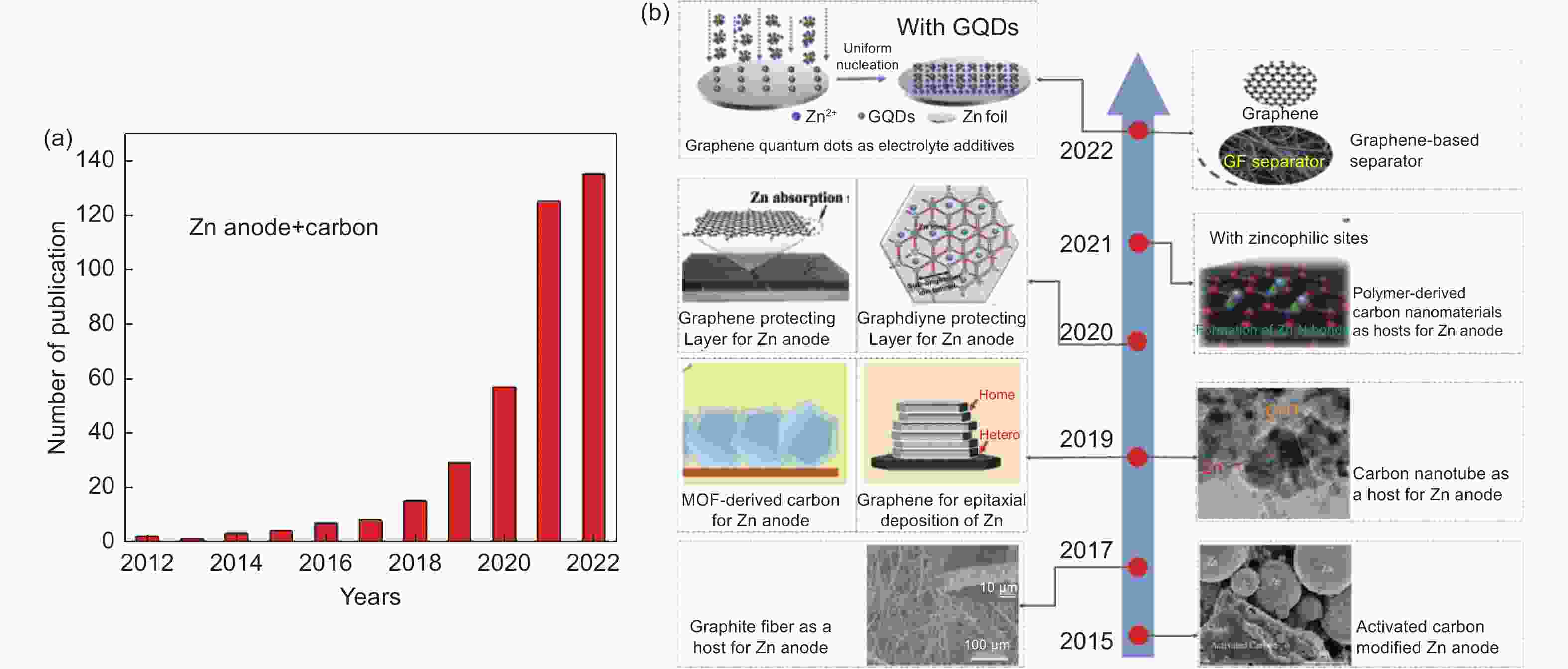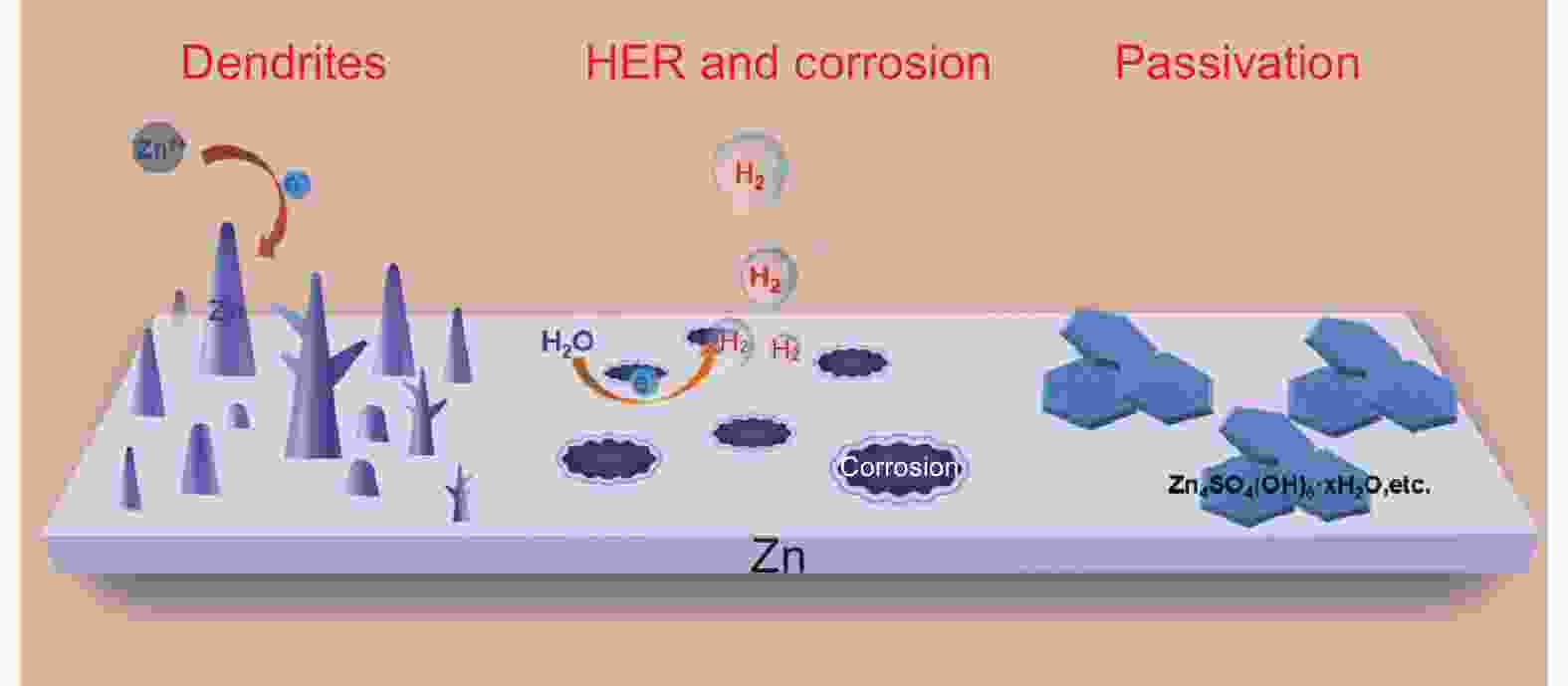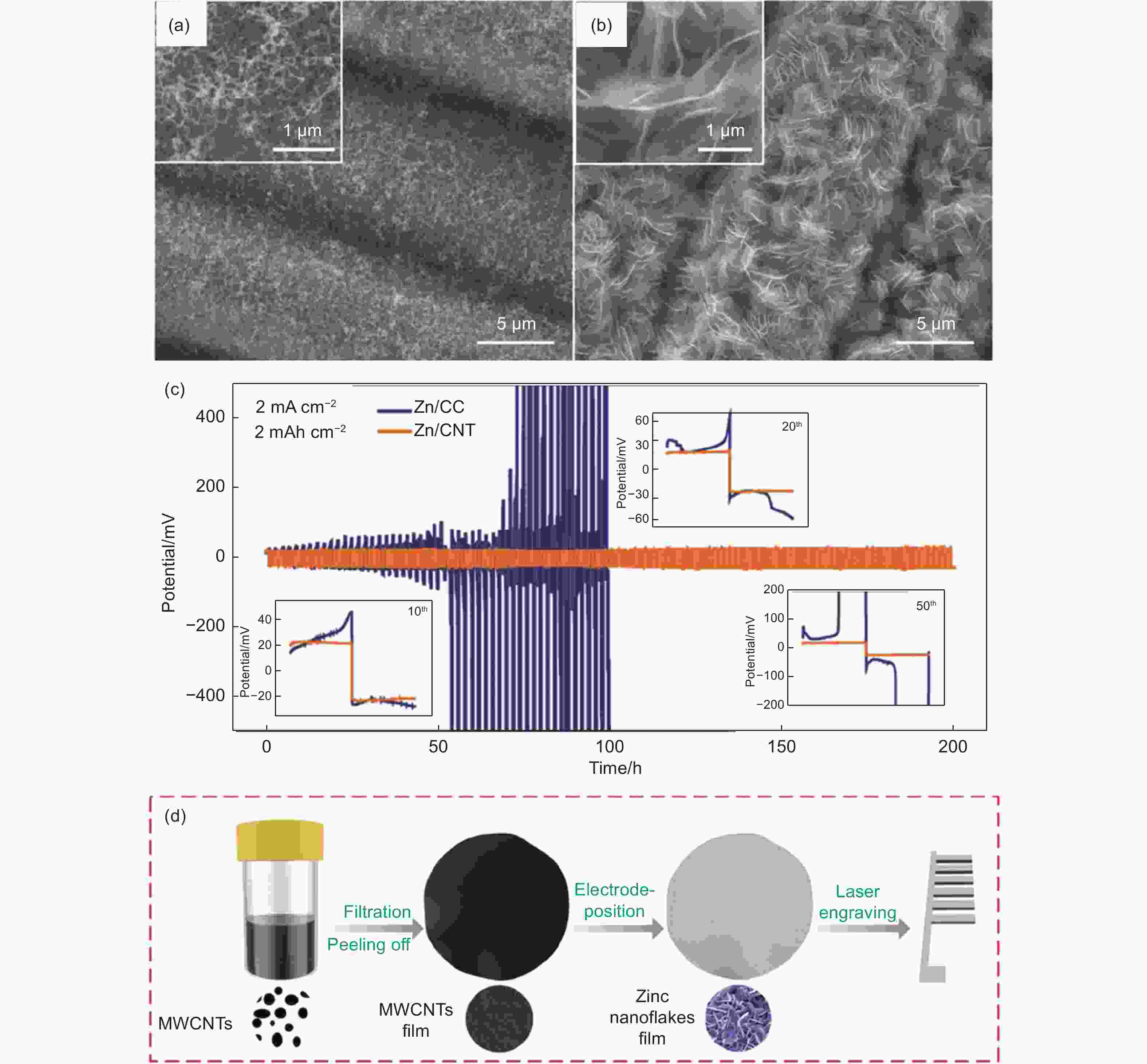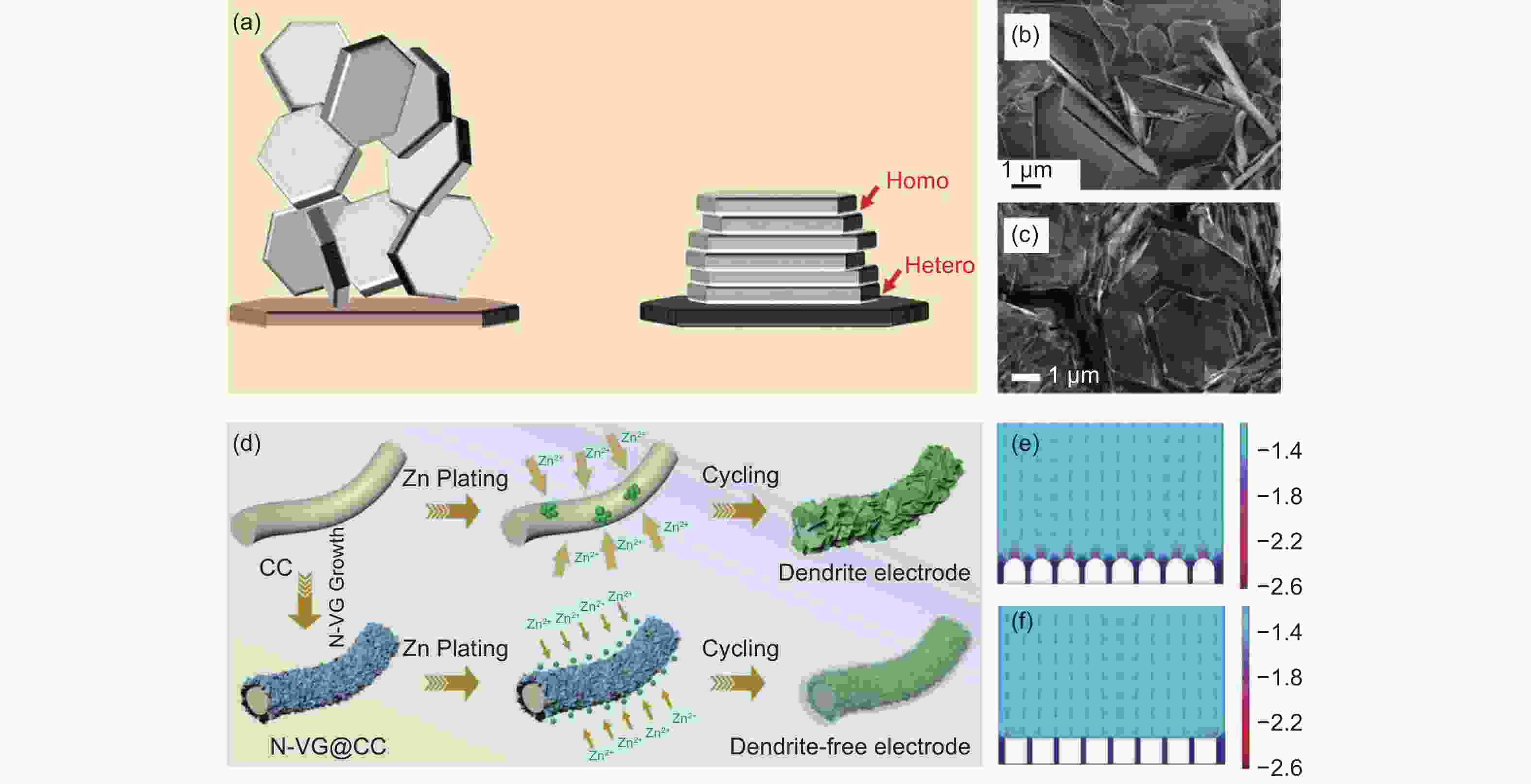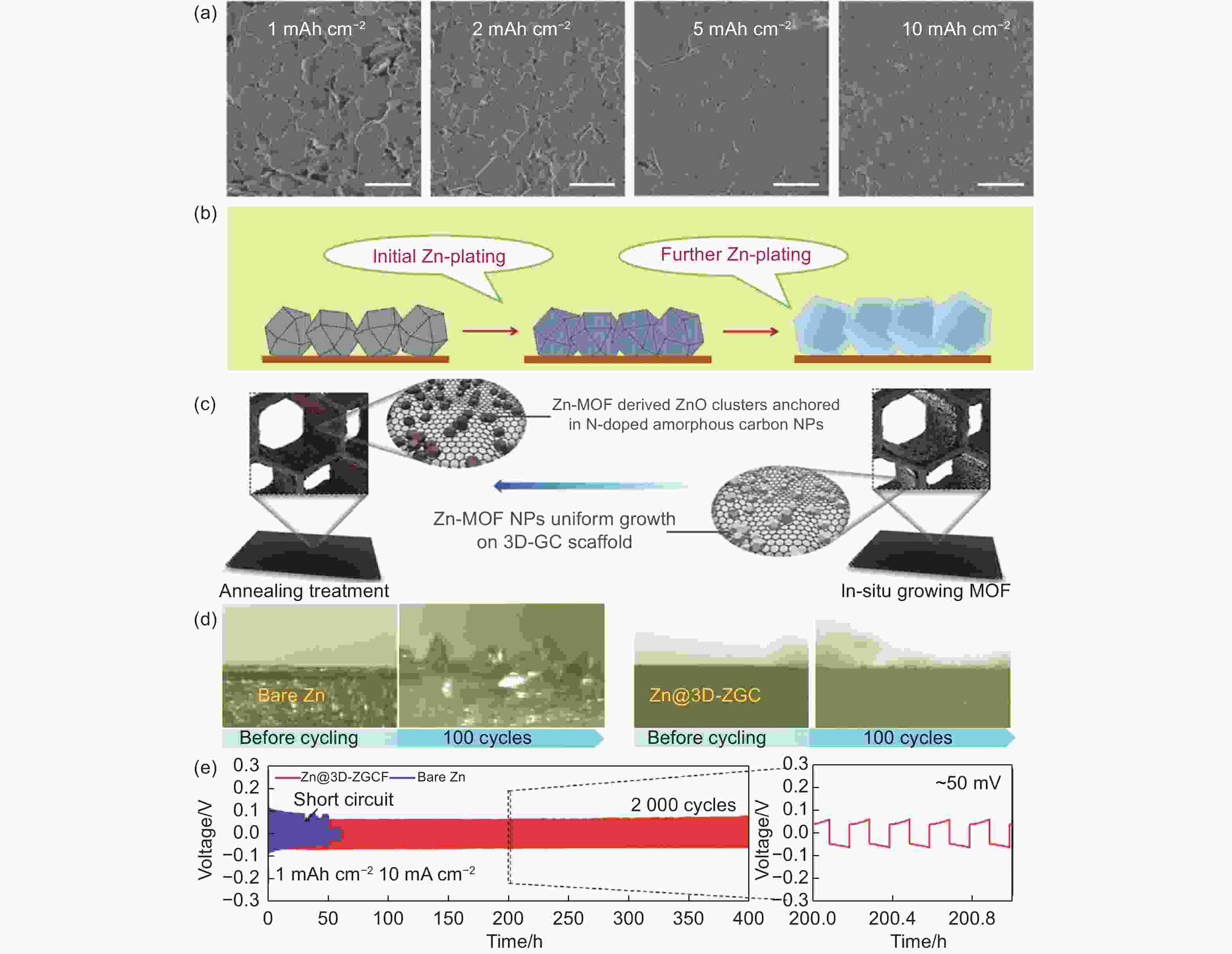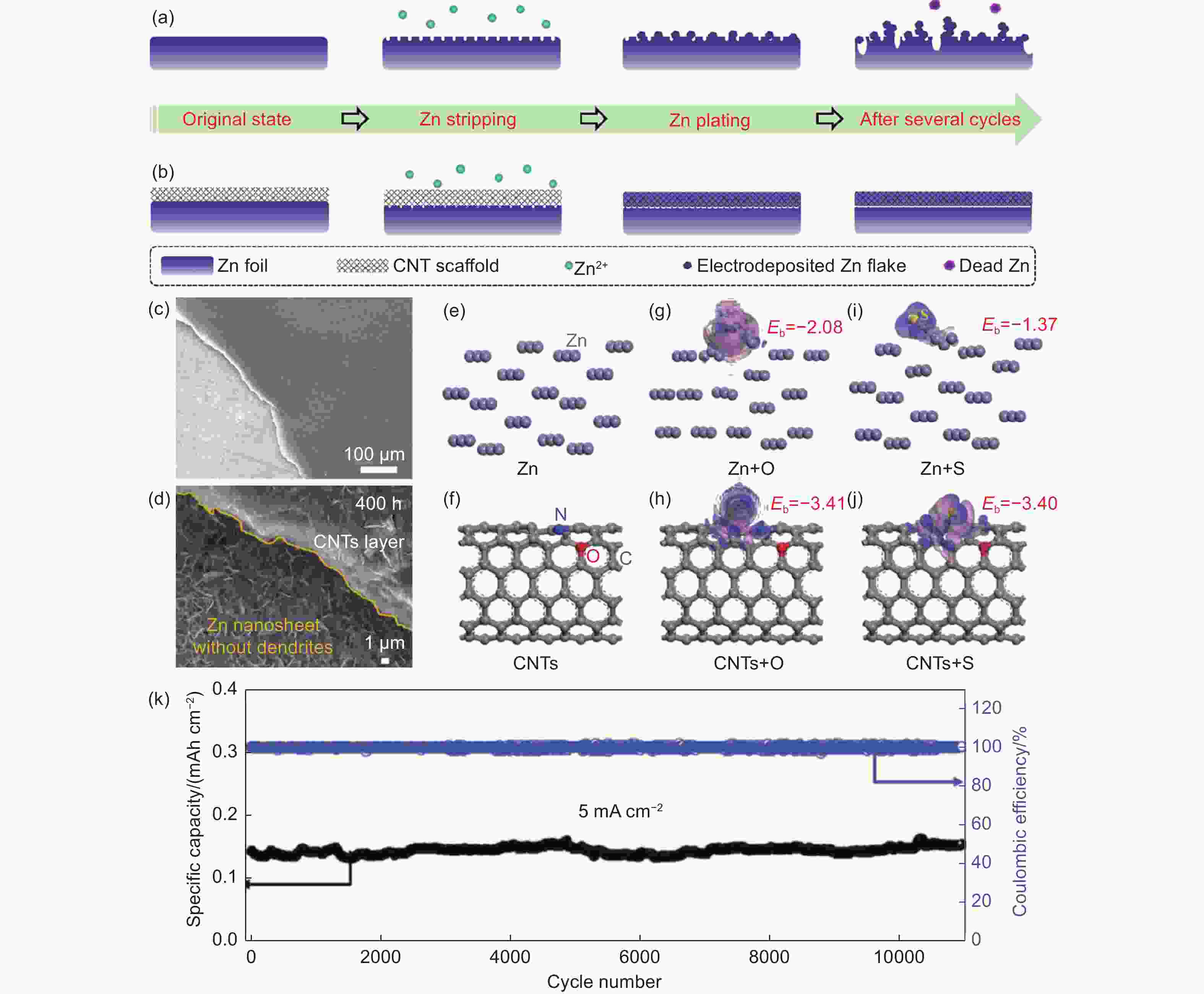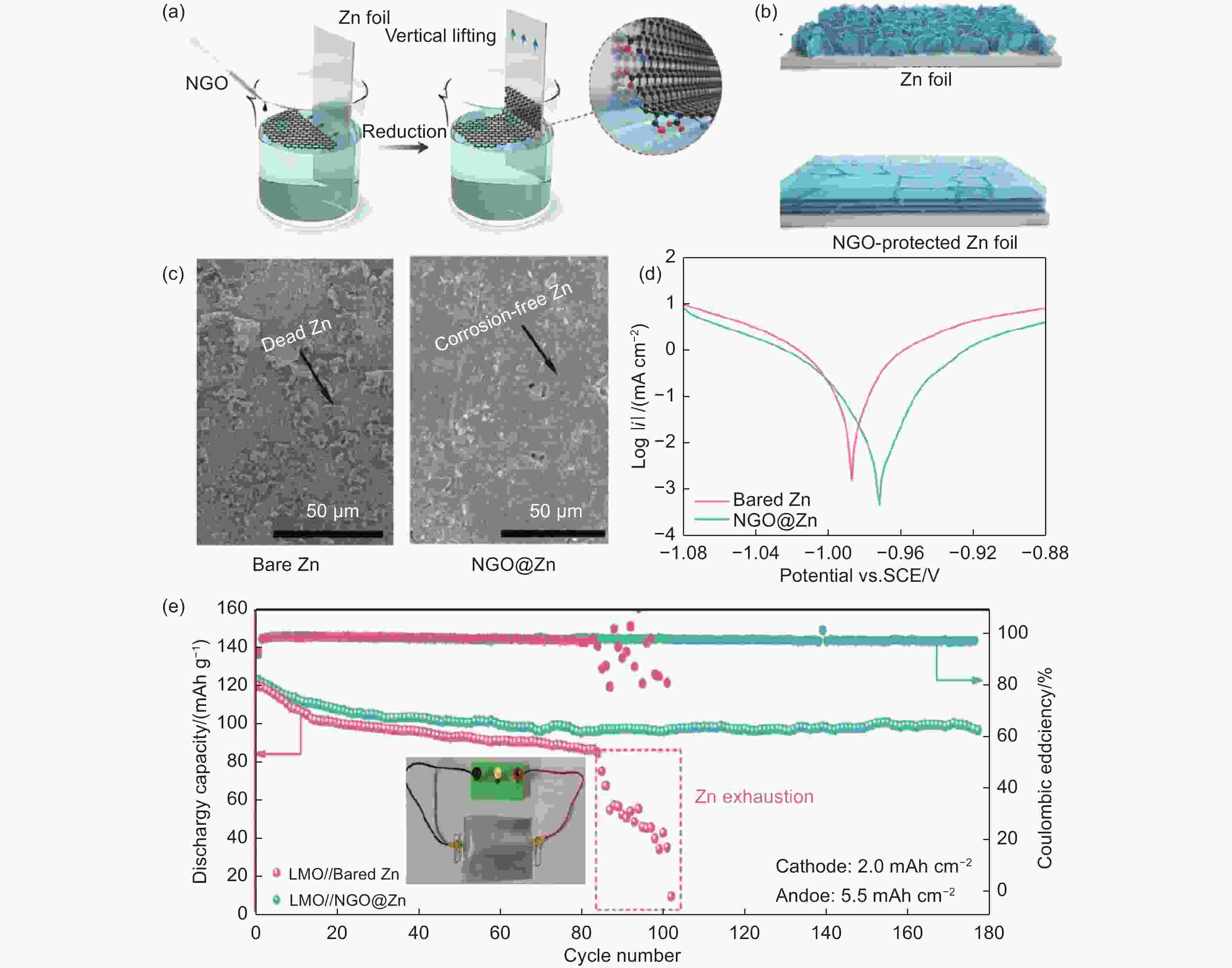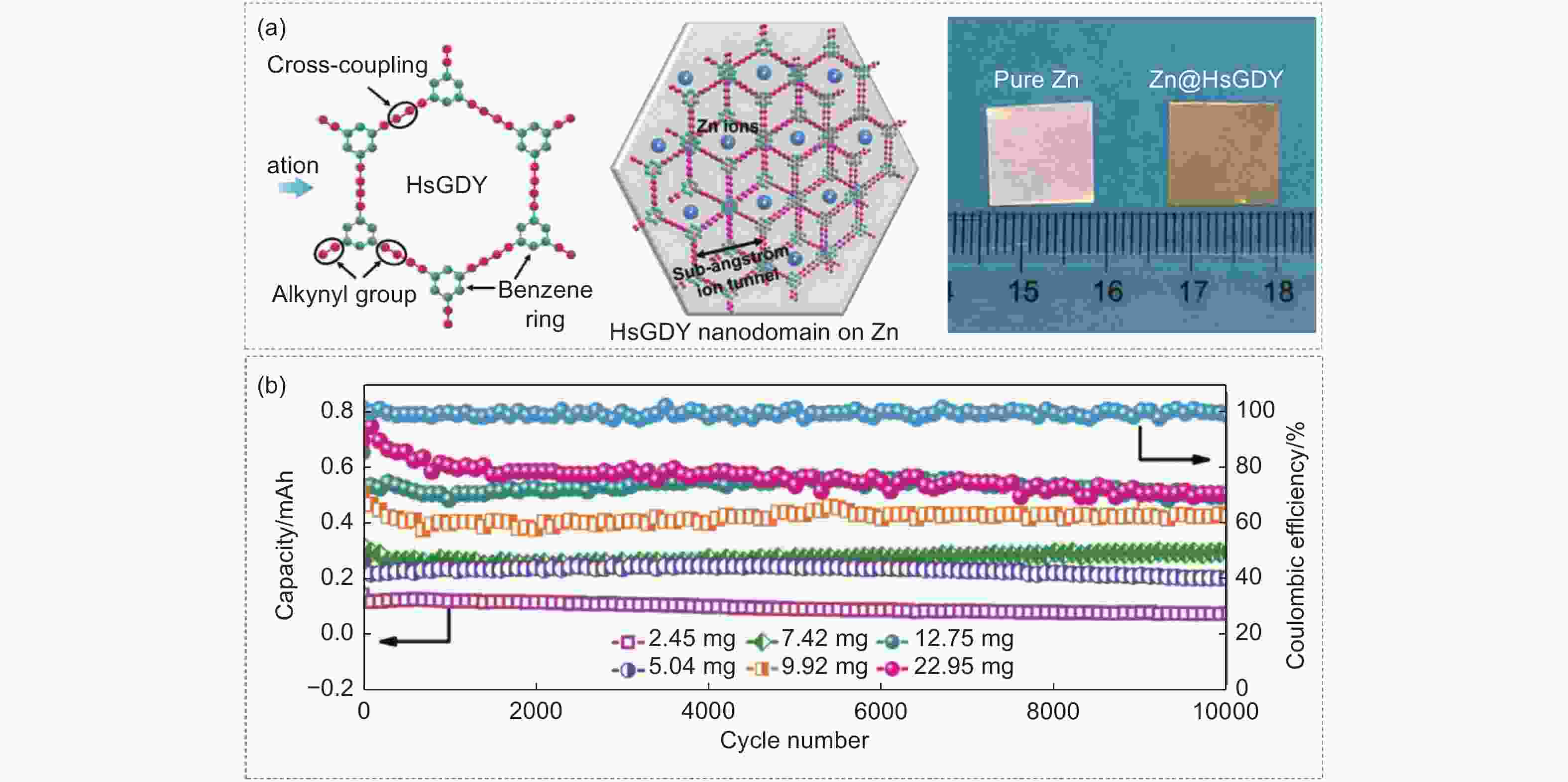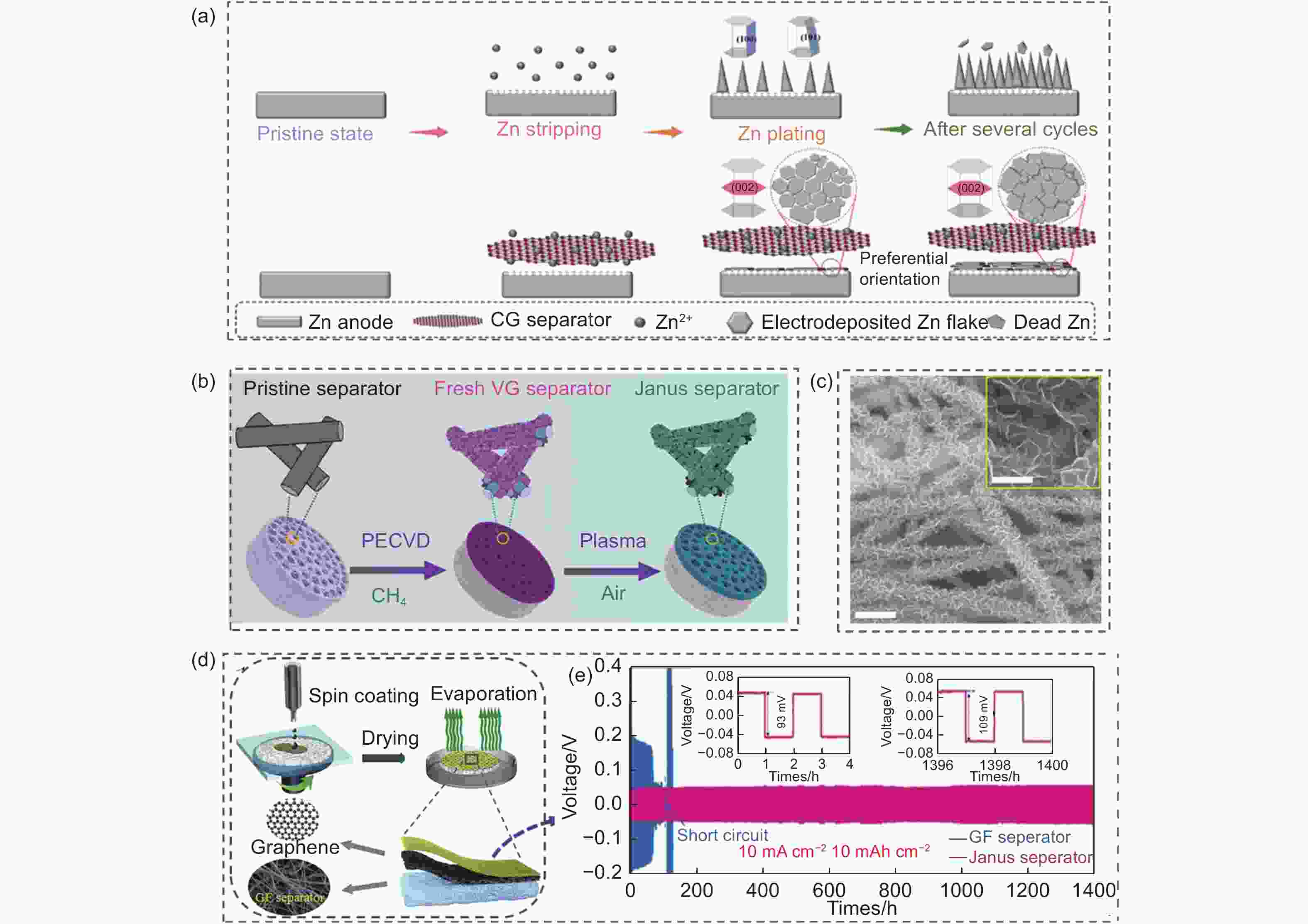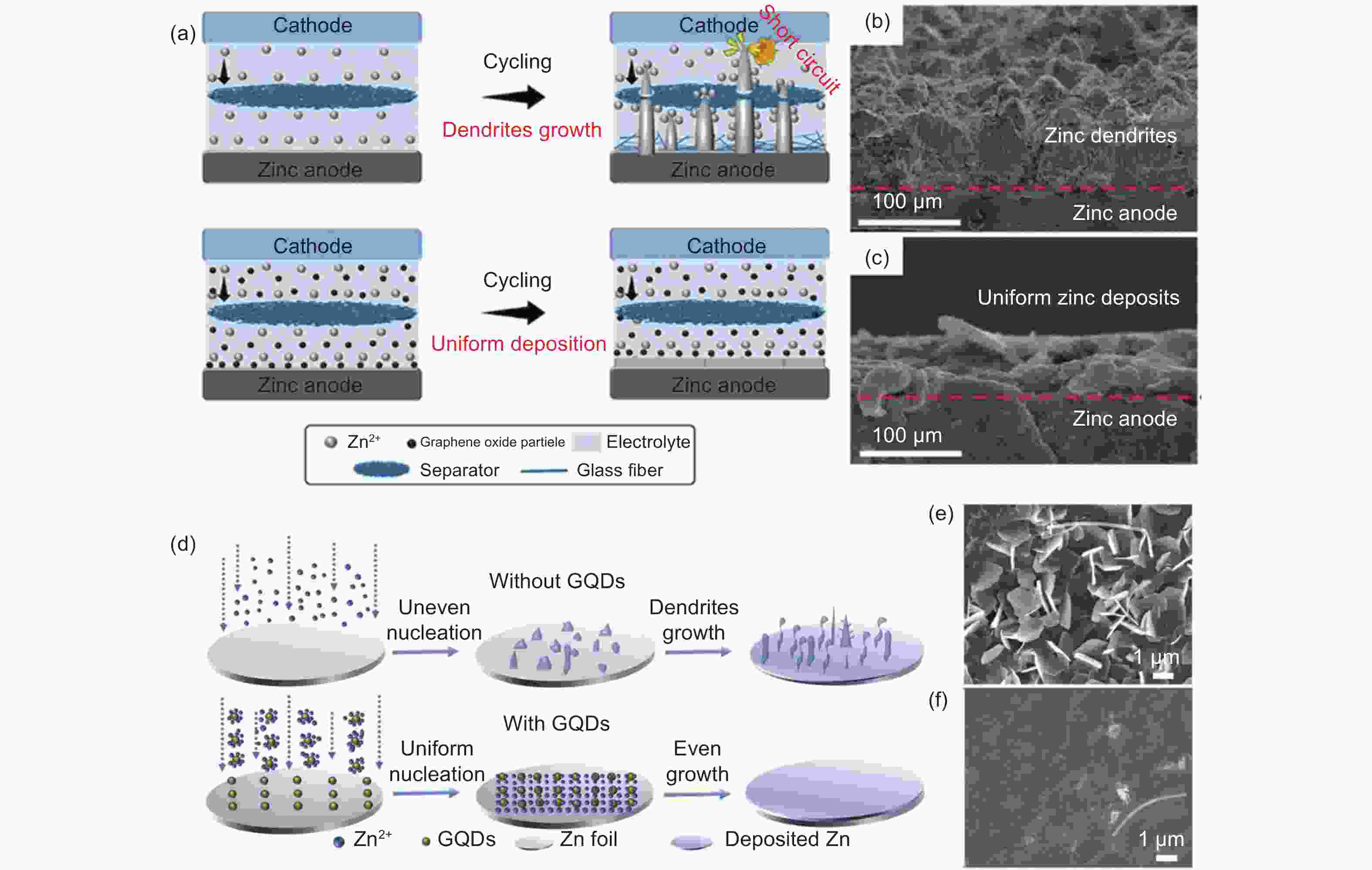-
摘要: 水系锌离子电池(ZIBs)由于价格低、安全性好、储能性能优异等优点,在电网和可穿戴设备中具有极大的前景。然而,锌离子电池的锌金属负极并不稳定,例如,锌负极上会形成锌枝晶,同时还会发生析氢反应和其他副反应。这些不稳定的因素阻碍了ZIBs的应用。最近,纳米炭材料因其独特的结构、优异的导电性和良好的稳定性成为优化锌负极的重要材料。这篇综述系统地概述了纳米炭材料用于稳定ZIBs中锌负极的最新进展。总结了纳米炭材料稳定锌负极的4种策略,包括使用炭材料作为基底、保护涂层、电解质添加剂和隔膜改性。最后,指出了纳米炭材料在稳定锌负极方面的挑战和前景。Abstract: Because of their low price, excellent safety and energy storage performance, aqueous zinc-ion batteries (ZIBs) have great potential for use in the power grid and in wearable devices. However, the Zn anode of ZIBs is not stable, for example, Zn dendrite can be formed on the Zn anode accompanied by hydrogen evolution and side reactions, leading to its instability, which has been an obstacle to its use. Carbon nanomaterials have recently been used to improve the performance of Zn anodes due to their unique structure, excellent conductivity and good stability. This review summarizes this recent development for stabilizing zinc anodes. The carbon nanomaterials are used are as hosts, protective coating layers, electrolyte additives and modifiers in the separators to stabilize the Zn electrodes. The problems involved in doing this are presented, and some future developments are outlined.
-
Key words:
- Zinc anode /
- Carbon nanomaterials /
- Graphene /
- Carbon nanotubes /
- Zinc dendrite
-
Figure 1. (a) Number of publications on carbon nanomaterials for stabilizing zinc anode, which was indexed by two topic keywords of ‘‘zinc anode’’ and ‘‘carbon’’ from the Web of Science. (b) Main progress of carbon nanomaterials as hosts, protecting layers, separators and electrolyte additives in aqueous ZIBs
Figure 4. (a) Scheme illustrating zinc metal crystals grown on a stainless steel substrate and a graphene coated stainless steel substrate. Scanning electron microscopy (SEM) images of Zn electrodeposition on (b) bare stainless steel and (c) graphene-coated stainless steel[16]. (d) The schematic illustrations of Zn deposition processes on CC and N-VG@CC electrodes. Models of the electric field distributions for (e) Zn@CC electrode and (f) Zn@N-VG@CC electrode after Zn nuclei formation[15]. Reprinted with permission
Figure 5. (a) SEM images of Zn anodes at areal capacities from 1 mAh cm−2 to 10 mAh cm−2. Scale bars, 2 mm. (b) Schematics of the Zn metal plating process on Zn@ZIF-8-500 anode[53]. (c) Schematics of the preparing process of the 3D-ZGC host. (d) The optical microscopy images of the Zn plating behavior on bare Zn foil and Zn@3D-ZGC anodes before and after 100 numbers of depositing/stripping cycles. (e) The cycling stability of the whole symmetrical batteries composited of the bare Zn foil (green line) and the Zn@3D-ZGC composite (read line) anodes at 10 mA cm−2 with a fixed capacity of 1 mAh cm−2[40]. Reprinted with permission
Figure 6. Schematic illustration of depositing/plating processes of (a) Zn foil electrodes and (b) CNT-stabilized Zn electrodes. SEM images of the carbon nanotubes covered Zn electrode (c) before, and (d) after cycling[65]. (e-j) The stabilized structures and the optimized configurations of Zn planes and CNTs adsorbing O and S. (k) The long-term cycling stability of a Mn2+/Zn2+ whole battery[66]. Reprinted with permission
Figure 7. (a) Schematics of graphene as a protecting layer on the Zn foil. (b) Schematics of Zn plating process on bare Zn foil (upper image) and NGO@Zn electrode (lower image). (c) SEM images of bare Zn (left) and NGO@Zn (right) electrodes after ten cycles. (d) The linear polarization curves of bare Zn and NGO@Zn electrodes. (e) The long-term stability of the whole pouch batteries of LMO//NGO@Zn and LMO//bare Zn, inset is an optical image of the pouch cell with the NGO@Zn anode and LMO cathode[18]. Reprinted with permission
Figure 8. (a) Structure of HsGDY, schematic illustration of HsGDY on Zn plate and digital images of Zn plate before and after HsGDY growth. (b) The cycling stability of Zn@HsGDY//C full cells with different cathodic loading masses[69]. Reprinted with permission
Figure 9. (a) Schematics of zinc depositing/plating processes with CG separators[74]. (b) Schematic illustration of the preparation process of graphene based Janus separator. (c) SEM image of VG carpet on the Janus separator, Scale bar: 1 μm. Inset: High-magnification SEM image of VG, Scale bar: 100 nm[75]. (d) Schematic illustration of the fabrication process of the Janus separator. (e) Long-term cycling stability of Zn/Zn symmetric cells with the GF separator/Janus separator at 10 mA cm−2[76]. Reprinted with permission
Figure 10. (a) Schematic illustration of ZIBs with and without GO electrolytes. Cross-section SEM images of the zinc anodes (b) without GO electrolyte additive and (c) with GO electrolyte additive after 200 cycles[20]. (d) Schematic presentation of the effect of GQD additive for suppressing dendrites growth. SEM images of zinc foil after 20 cycles at 0.8 mA cm−2 (e) without GQDs and (f) with GQDs[78]. Reprinted with permission
Table 1. Performance of recently reported carbon nanomaterials as hosts for Zn anode
Anode Carbon nanomaterials Voltage hysteresis Life span Coulombic efficiency Cycling stability Ref. Zn/CNT CNT 27 mV 200 h (2 mA cm−2) 97.9% (5 mA cm−2) 88.7% (1000 cycles) [35] Zn/CNT foam CNT foam 143 mV 10000 min (3 mA cm−2) — 82.0% (5000 cycles) [36] MGA@Zn Mxene/ graphene 64 mV 1050 h (10 mA cm−2) 99.7% (10 mA cm−2) 60 cycles [39] Zn@N-VG@CC N-doped vertical graphene ~6 mV 150 h (0.5 mA cm−2) >95.0% (5 mA cm−2) 80.0% (300 cycles) [15] Zn/GCF graphene — 100 h (1mA cm−2) 100.0% (0.2 mA cm−2) 1000 cycles [57] NLSG-Zn Laser-scribed graphene 18 mV 250 h (1 mA cm−2) 99.4% (2 mA cm−2) 72.3% (1200 cycles) [58] Zn@3D-ZGC Graphene/carbon nanotube ~50 mV 400 h (10 mA cm−2) — 80.8% (6000 cycles) [40] Zn@ZIF-8-500 MOFs derived carbon — — 98.6% (2.0 mA cm−2) 72.0% (20000 cycles) [53] Zn@NOCA@CF CF — 240 h (1 mA cm−2) 95.7% (1 mA cm−2) 200 cycles [52] Zn@TiO2/NC MOFs derived N-doped carbon ~60 mV 1100 h (5 mA cm−2) 99.4% (2.0 mA cm−2) 75.0% (1000 cycles) [59] Sn@NHCF N-doped hollow carbon spheres 21 mV 370 h (1 mA cm−2) 99.7% (5.0 mA cm−2) 2400 cycles [45] HSTF 3D hollow SiO2/TiO2/CF 122 mV 600 h (10 mA cm−2) 99.5% (20.0 mA cm−2) 85.0% (10000cycles) [43] Table 2. Performance of carbon nanomaterials as protecting layer for Zn anode
Anode Carbon nanomaterial Voltage hysteresis Life span Coulombic efficiency Cycling stability Ref. Zn@CNTS CNTs 36 mV 1800 h (0.1 mA cm−2) — 100% (7000 cycles) [65] Zn-CNTs CNTs 80 mV 600 h (0.5 mA cm−2) — 11000 cycles [66] Zn/rGO RGO — 300 h (1 mA cm−2) — 88.5% (5000 cycles) [17] FLG@Zn Few-layer graphene — 500 h (1 mA/cm−2) 98.0% (1 mA cm−2) 97.0% (5000 cycles) [72] Zn/rGO RGO 170 mV 200 h (10 mA cm−2) — 79.0% (1000 cycles) [73] CNG-Zn Bifunctional cellulose nanowhisker-
graphene composite31 mV 5500 h (0.25 cm−2) 99.4% (0.5 mA cm−2) 87.8% (5000 cycles) [67] NGO@Zn N-doped graphene oxide 17 mV 1200 h (1 mA cm−2) 99.5% (5 mA cm−2) 94.0% (300 cycles) [18] PEDOT:PSS/GS@Zn PEDOT:PSS/GS — 500 h (1 mA cm−2) 98.0% (1 mA cm−2) 8000 cycles [68] Zn@HsGDY Graphdiyne 2400 h (2 mA cm−2) nearly 100% 50000 cycles [69] -
[1] Huang M, Wang X P, Liu X, et al. Fast ionic storage in aqueous rechargeable batteries: From fundamentals to applications[J]. Advanced Materials,2022,34(9):2105611. doi: 10.1002/adma.202105611 [2] Chen Y Q, Kang Y Q, Zhao Y, et al. A review of lithium-ion battery safety concerns: The issues, strategies, and testing standards[J]. Journal of Energy Chemistry,2021,59:83-99. doi: 10.1016/j.jechem.2020.10.017 [3] Jia Y K, Liu B H, Hong Z G, et al. Safety issues of defective lithium-ion batteries: Identification and risk evaluation[J]. Journal of Materials Chemistry A,2020,8(25):12472-12484. doi: 10.1039/D0TA04171H [4] Li J L, Fleetwood J, Hawley W B, et al. From materials to cell: State-of-the-art and prospective technologies for lithium-ion battery electrode processing[J]. Chemical Reviews,2022,122(1):903-956. doi: 10.1021/acs.chemrev.1c00565 [5] Zhang N, Chen X Y, Yu M, et al. Materials chemistry for rechargeable zinc-ion batteries[J]. Chemical Society Reviews,2020,49(13):4203-4219. doi: 10.1039/C9CS00349E [6] Li C P, Xie X S, Liang S Q, et al. Issues and future perspective on zinc metal anode for rechargeable aqueous zinc-ion batteries[J]. Energy & Environmental Materials,2020,3(2):146-159. [7] Zhang Q, Luan J Y, Tang Y G, et al. Interfacial design of dendrite-free zinc anodes for aqueous zinc-ion batteries[J]. Angewandte Chemie-International Edition,2020,59(32):13180-13191. doi: 10.1002/anie.202000162 [8] Zheng J X, Huang Z H, Ming F W, et al. Surface and interface engineering of zn anodes in aqueous rechargeable zn-ion batteries[J]. Small,2022,18(21):2200006. doi: 10.1002/smll.202200006 [9] Li Y, Wu L S, Dong C, Wang X, et al. Manipulating horizontal Zn deposition with graphene interpenetrated Zn hybrid foils for dendrite-free aqueous Zinc ion batteries [J]. Energy & Environmental Materials, 2023. [10] Wang T, Xi Q, Li Y F, et al. Regulating dendrite-free zinc deposition by red phosphorous-derived artificial protective layer for zinc metal batteries[J]. Advanced Science,2022,9(18):2200155. doi: 10.1002/advs.202200155 [11] Chen G Y, Sang Z Y, Cheng J H, et al. Reversible and homogenous zinc deposition enabled by in-situ grown Cu particles on expanded graphite for dendrite-free and flexible zinc metal anodes[J]. Energy Storage Materials,2022,50:589-597. doi: 10.1016/j.ensm.2022.05.036 [12] Dai L M, Xue Y H, Qu L T, C et al. Metal-free catalysts for oxygen reduction reaction[J]. Chemical Reviews,2015,115(11):4823-4892. doi: 10.1021/cr5003563 [13] Wu L S and Dong Y F. Recent progress of carbon nanomaterials for high-performance cathodes and anodes in aqueous zinc ion batteries[J]. Energy Storage Materials,2021,41:715-737. doi: 10.1016/j.ensm.2021.07.004 [14] Wu L S, Zhang M H, Xu W, et al. Recent advances in carbon materials for flexible zinc ion batteries[J]. New Carbon Materials,2022,37(5):827-851. doi: 10.1016/S1872-5805(22)60628-0 [15] Cao Q H, Gao H, Gao Y, Yang J, et al. Regulating dendrite-free zinc deposition by 3D zincopilic nitrogen-doped vertical graphene for high-performance flexible Zn-ion batteries[J]. Advanced Functional Materials,2021,31(37):2103922. doi: 10.1002/adfm.202103922 [16] Zheng J X, Zhao Q, Tang T, et al. Reversible epitaxial electrodeposition of metals in battery anodes[J]. Science,2019,366(6465):645-648. doi: 10.1126/science.aax6873 [17] Xia A L, Pu X M, Tao Y Y, et al. Graphene oxide spontaneous reduction and self-assembly on the zinc metal surface enabling a dendrite-free anode for long-life zinc rechargeable aqueous batteries[J]. Applied Surface Science,2019,481:852-859. doi: 10.1016/j.apsusc.2019.03.197 [18] Zhou J H, Xie M, Wu F, et al. Ultrathin surface coating of nitrogen-doped graphene enables stable zinc anodes for aqueous zinc-ion batteries[J]. Advanced Materials,2021,33(33):2101649. doi: 10.1002/adma.202101649 [19] Mao C W, Chang Y X, Zhao X T et al. Functional carbon materials for high-performance Zn metal anodes[J]. Journal of Energy Chemistry,2022,75:135-153. doi: 10.1016/j.jechem.2022.07.034 [20] Abdulla J, Cao J, Zhang D D, et al. Elimination of zinc dendrites by graphene oxide electrolyte additive for zinc-ion batteries[J]. ACS Applied Energy Materials,2021,4(5):4602-4609. doi: 10.1021/acsaem.1c00224 [21] Li T C, Fang D L, Zhang J T, et al. Recent progress in aqueous zinc-ion batteries: a deep insight into zinc metal anodes[J]. Journal of Materials Chemistry A,2021,9(10):6013-6028. doi: 10.1039/D0TA09111A [22] Ma L T, Li Q, Ying Y R, et al. Toward practical high-areal-capacity aqueous zinc-metal batteries: Quantifying hydrogen evolution and a solid-ion conductor for stable zinc anodes[J]. Advanced Materials,2021,33(12):e2007406. doi: 10.1002/adma.202007406 [23] Lu W J, Xie C X, Zhang H M, et al. Inhibition of zinc dendrite growth in zinc-based batteries[J]. Chemsuschem,2018,11(23):3996-4006. doi: 10.1002/cssc.201801657 [24] Wang F, Borodin O, Gao T, et al. Highly reversible zinc metal anode for aqueous batteries[J]. Nature Materials,2018,17(6):543-549. doi: 10.1038/s41563-018-0063-z [25] Yang J Z, Yin B S, Sun Y, et al. Zinc anode for mild aqueous zinc-ion batteries: Challenges, strategies, and perspectives[J]. Nano-Micro Letters,2022,14(1):42. doi: 10.1007/s40820-021-00782-5 [26] Yang Q, Bang G J, Guo Y, et al. Do zinc dendrites exist in neutral zinc batteries: A developed electrohealing strategy to in situ rescue in-service batteries[J]. Advanced Materials,2019,31(43):1903778. doi: 10.1002/adma.201903778 [27] Xie C L, Li Y H, Wang Q, et al. Issues and solutions toward zinc anode in aqueous zinc-ion batteries: A mini review[J]. Carbon Energy,2020,2(4):540-560. doi: 10.1002/cey2.67 [28] Wan F, Zhou X Z, Lu Y, et al. Energy storage chemistry in aqueous zinc metal batteries[J]. Acs Energy Letters,2020,5(11):3569-3590. doi: 10.1021/acsenergylett.0c02028 [29] Bayaguud A, Fu Y P and Zhu C B. Interfacial parasitic reactions of zinc anodes in zinc ion batteries: Underestimated corrosion and hydrogen evolution reactions and their suppression strategies[J]. Journal of Energy Chemistry,2022,64:246-262. doi: 10.1016/j.jechem.2021.04.016 [30] Wang T T, Li C P, Xie X S, et al. Anode materials for aqueous zinc ion batteries: Mechanisms, properties, and perspectives[J]. Acs Nano,2020,14(12):16321-16347. doi: 10.1021/acsnano.0c07041 [31] Zhou M, Chen Y, Fang G Z, et al. Electrolyte/electrode interfacial electrochemical behaviors and optimization strategies in aqueous zinc-ion batteries[J]. Energy Storage Materials,2022,45:618-646. doi: 10.1016/j.ensm.2021.12.011 [32] Fang G Z, Zhou J, Pan A Q, et al. Recent advances in aqueous zinc-ion batteries[J]. Acs Energy Letters,2018,3(10):2480-2501. doi: 10.1021/acsenergylett.8b01426 [33] Yuan L B, Hao J N, Kao C C, et al. Regulation methods for the Zn/electrolyte interphase and the effectiveness evaluation in aqueous Zn-ion batteries[J]. Energy & Environmental Science,2021,14(11):5669-5689. [34] Zheng X H, Ahmad T and Chen W. Challenges and strategies on Zn electrodeposition for stable Zn-ion batteries[J]. Energy Storage Materials,2021,39:365-394. doi: 10.1016/j.ensm.2021.04.027 [35] Zeng Y X, Zhang X Y, Qin R F, et al. endrite-free zinc deposition induced by multifunctional CNT frameworks for stable flexible Zn-ion batteries[J]. Advanced Materials,2019,31(36):1903675. doi: 10.1002/adma.201903675 [36] Zhou Y R, Wang X N, Shen X F, et al. 3D confined zinc plating/stripping with high discharge depth and excellent high-rate reversibility[J]. Journal of Materials Chemistry A,2020,8(23):11719-11727. doi: 10.1039/D0TA02791J [37] Shi J J, Wang S L, Chen X, et al. An ultrahigh energy density quasi-solid-state zinc ion microbattery with excellent flexibility and thermostability[J]. Advanced Energy Materials,2019,9(37):1901957. doi: 10.1002/aenm.201901957 [38] Wu B K, Guo B B, Chen Y Z, et al. High zinc utilization aqueous zinc ion batteries enabled by 3D printed graphene arrays[J]. Energy Storage Materials,2023,54:75-84. doi: 10.1016/j.ensm.2022.10.017 [39] Zhou J H, Xie M, Wu F, et al. Encapsulation of metallic Zn in a hybrid MXene/graphene aerogel as a stable zn anode for foldable Zn-Ion batteries[J]. Advanced Materials,2022,34(1):2106897. doi: 10.1002/adma.202106897 [40] Xue P, Guo C, Li L, et al. A MOF-Derivative Decorated Hierarchical Porous Host Enabling Ultrahigh Rates and Superior Long-Term Cycling of Dendrite-Free Zn Metal Anodes[J]. Advanced Materials,2022,34(14):2110047. doi: 10.1002/adma.202110047 [41] Qiao Z Y and Ding C M. Recent progress in carbon fibers for boosting electrocatalytic energy conversion[J]. Ionics,2022,28(12):5259-5273. doi: 10.1007/s11581-022-04664-7 [42] Wang L P, Li N W, Wang T S, et al. Conductive graphite fiber as a stable host for zinc metal anodes[J]. Electrochimica Acta,2017,244:172-177. doi: 10.1016/j.electacta.2017.05.072 [43] Xue P, Guo C, Wang N Y, et al. Synergistic manipulation of zn2+ ion flux and nucleation induction effect enabled by 3D hollow SiO2/TiO2/carbon fiber for long-lifespan and dendrite-free Zn-metal composite anodes[J]. Advanced Functional Materials,2021,31(50):2106417. doi: 10.1002/adfm.202106417 [44] Zeng Y X, Sun P X, Pei Z H, et al. Nitrogen-doped carbon fibers embedded with zincophilic Cu nanoboxes for stable Zn-metal anodes[J]. Advanced Materials,2022,34(18):2200342. doi: 10.1002/adma.202200342 [45] Yu H, Zeng Y X, Li N W, et al. Confining Sn nanoparticles in interconnected N-doped hollow carbon spheres as hierarchical zincophilic fibers for dendrite-free Zn metal anodes[J]. Science Advances,2022,8(10):eabm5766. doi: 10.1126/sciadv.abm5766 [46] Wang Q and Astruc D. State of the art and prospects in metal-organic framework (MOF)-based and MOF-derived nanocatalysis[J]. Chemical Reviews,2020,120(2):1438-1511. doi: 10.1021/acs.chemrev.9b00223 [47] Wang Z, Xu J, Yang J H, Xue Y H, et al. Ultraviolet/ozone treatment for boosting OER activity of MOF nanoneedle arrays[J]. Chemical Engineering Journal,2022,427:131498. doi: 10.1016/j.cej.2021.131498 [48] Yuksel R, Buyukcakir O, Seong W K, et al. Metal-organic framework integrated anodes for aqueous zinc-ion batteries[J]. Advanced Energy Materials,2020,10(16):1904215. doi: 10.1002/aenm.201904215 [49] Yang H J, Chang Z, Qiao Y, et al. Constructing a Super-Saturated Electrolyte Front Surface for Stable Rechargeable Aqueous Zinc Batteries[J]. Angewandte Chemie-International Edition,2020,59(24):9377-9381. doi: 10.1002/anie.202001844 [50] Yang W P, Li X X, Li Y, et al. Applications of metal-organic-framework-derived carbon materials[J]. Advanced Materials,2019,31(6):1804740. [51] Yang L, Zeng X F, Wang W C, et al. Recent Progress in MOF-Derived, Heteroatom-Doped Porous Carbons as Highly Efficient Electrocatalysts for Oxygen Reduction Reaction in Fuel Cells[J]. Advanced Functional Materials,2018,28(7):1704537. doi: 10.1002/adfm.201704537 [52] An Y L, Tian Y, Li Y, Wei C L, et al. Heteroatom-doped 3D porous carbon architectures for highly stable aqueous zinc metal batteries and non-aqueous lithium metal batteries[J]. Chemical Engineering Journal,2020,400:125843. doi: 10.1016/j.cej.2020.125843 [53] Wang Z, Huang J H, Guo Z W, D et al. A Metal-organic framework host for highly reversible dendrite-free zinc metal anodes[J]. Joule,2019,3(5):1289-1300. doi: 10.1016/j.joule.2019.02.012 [54] Wang H, Shao Y, Mei S L, et al. Polymer-derived heteroatom-doped porous carbon materials[J]. Chemical Reviews,2020,120(17):9363-9419. doi: 10.1021/acs.chemrev.0c00080 [55] Xie F X, Li H, Wang X S, et al. Mechanism for Zincophilic Sites on Zinc-Metal Anode Hosts in Aqueous Batteries[J]. Advanced Energy Materials,2021,11(9):2003419. doi: 10.1002/aenm.202003419 [56] Xu Z X, Jin S, Zhang N J, et al. Efficient Zn metal anode enabled by O, N-codoped carbon microflowers[J]. Nano Letters,2022,22(3):1350-1357. doi: 10.1021/acs.nanolett.1c04709 [57] Wu Y Z, Wang M C, Tao Y, et al. Electrochemically derived graphene-like carbon film as a superb substrate for high-performance aqueous zn-ion batteries[J]. Advanced Functional Materials,2020,30(5):1907120. doi: 10.1002/adfm.201907120 [58] Guo J, Zhang W L, Yin J, et al. Zincophilic Laser-Scribed Graphene Interlayer for Homogeneous Zinc Deposition and Stable Zinc-Ion Batteries[J]. Energy Technology,2021,9(10):2100490. doi: 10.1002/ente.202100490 [59] Xu Q J, Zhou W C, Xin T, et al. Practical Zn anodes enabled by a Ti-MOF-derived coating for aqueous batteries[J]. Journal of Materials Chemistry A,2022,10(22):12247-12257. doi: 10.1039/D2TA02711A [60] Gan H, Wu J, Li R, et al. Ultra-stable and deeply rechargeable zinc metal anode enabled by a multifunctional protective layer[J]. Energy Storage Materials,2022,47:602-610. doi: 10.1016/j.ensm.2022.02.040 [61] Liu M Q, Yang L Y, Liu H, et al. Artificial solid-electrolyte interface facilitating dendrite-free zinc metal anodes via nanowetting effect[J]. Acs Applied Materials & Interfaces,2019,11(35):32046-32051. [62] An Y L, Tian Y, Liu C K, et al. Rational design of sulfur-doped three-dimensional Ti3C2Tx MXene/ZnS heterostructure as multifunctional protective layer for dendrite-free zinc-ion batteries[J]. Acs Nano,2021,15(9):15259-15273. doi: 10.1021/acsnano.1c05934 [63] Yang Y, Liu C Y, Lv Z H, et al. Redistributing Zn-ion flux by interlayer ion channels in Mg-Al layered double hydroxide-based artificial solid electrolyte interface for ultra-stable and dendrite-free Zn metal anodes[J]. Energy Storage Materials,2021,41:230-239. doi: 10.1016/j.ensm.2021.06.002 [64] Hieu L T, So S, Kim I T, et al. Zn anode with flexible beta-PVDF coating for aqueous Zn-ion batteries with long cycle life[J]. Chemical Engineering Journal,2021,411:128584. doi: 10.1016/j.cej.2021.128584 [65] Dong L B, Yang W, Yang W, et al. Flexible and conductive scaffold-stabilized zinc metal anodes for ultralong-life zinc-ion batteries and zinc-ion hybrid capacitors[J]. Chemical Engineering Journal,2020,384:123355. doi: 10.1016/j.cej.2019.123355 [66] Li M, He Q, Li Z L, Li Q, Zhang Y X, Meng J S, Liu X, Li S D, Wu B K, Chen L N, Liu Z, Luo W, Han C H and Mai L Q. A Novel Dendrite-Free Mn2+/Zn2+ Hybrid Battery with 2. 3A novel dendrite-free Mn2+/Zn2+ hybrid battery with 2. 3 V voltage window and 11000-cycle lifespan[J]. Advanced Energy Materials,2019,9(29):1901469. doi: 10.1002/aenm.201901469 [67] Zhang X T, Li J X, Liu D Y, et al. Ultra-long-life and highly reversible Zn metal anodes enabled by a desolvation and deanionization interface layer[J]. Energy & Environmental Science,2021,14(5):3120-3129. [68] Qiu M H, Wang D, Tawiah B, et al. Constructing PEDOT: PSS/Graphene sheet nanofluidic channels to achieve dendrite-free Zn anode[J]. Composites Part B-Engineering,2021,215:108798. doi: 10.1016/j.compositesb.2021.108798 [69] Yang Q, Guo Y, Yan B X, et al. Hydrogen-Substituted Graphdiyne Ion Tunnels Directing Concentration Redistribution for Commercial-Grade Dendrite-Free Zinc Anodes[J]. Advanced Materials,2020,32(25):2001755. doi: 10.1002/adma.202001755 [70] Yin C, Zhu M, Kong Y, et al. Rapid synthesis of few-layer graphdiyne using radio frequency heating and its application for dendrite-free zinc anodes[J]. 2d Materials,2021,8(4):044003. doi: 10.1088/2053-1583/ac105a [71] Wang F H, Xiong Z C, Jin W Y, et al. Graphdiyne oxide for aqueous zinc ion full battery with ultra-long cycling stability[J]. Nano Today,2022,44:101463. doi: 10.1016/j.nantod.2022.101463 [72] Qiu M H, Jia H, Liu H Q, et al. Realizing Long-life Zn Anode by Few-layer Graphene Ion-oriented Interface[J]. Journal of Alloys and Compounds,2022,891:161886. doi: 10.1016/j.jallcom.2021.161886 [73] Shen C, Li X, Li N, Xi et al. Graphene-boosted, high-performance aqueous Zn-ion battery[J]. Acs Applied Materials & Interfaces,2018,10(30):25446-25453. [74] Cao J, Zhang D D, Gu C, et al. Manipulating crystallographic orientation of zinc deposition for dendrite-free zinc ion batteries[J]. Advanced Energy Materials,2021,11(29):2101299. doi: 10.1002/aenm.202101299 [75] Li C, Sun Z T, Yang T, et al. Directly Grown Vertical Graphene Carpets as Janus Separators toward Stabilized Zn Metal Anodes[J]. Advanced Materials,2020,32(33):2003425. doi: 10.1002/adma.202003425 [76] Zhang X T, Li J X, Qi K W, et al. An ion-sieving janus separator toward planar electrodeposition for deeply rechargeable Zn-metal anodes[J]. Advanced Materials,2022,34(38):2205175. doi: 10.1002/adma.202205175 [77] Yang Q, Li L, Hussain T, et al. Stabilizing interface ph by N-modified graphdiyne for dendrite-free and high-rate aqueous Zn-ion batteries[J]. Angewandte Chemie-International Edition,2022,61(6):e202112304. doi: 10.1002/anie.202112304 [78] Zhang H, Guo R T, Li S, et al. Graphene quantum dots enable dendrite-free zinc ion battery[J]. Nano Energy,2022,92:106752. doi: 10.1016/j.nanoen.2021.106752 -





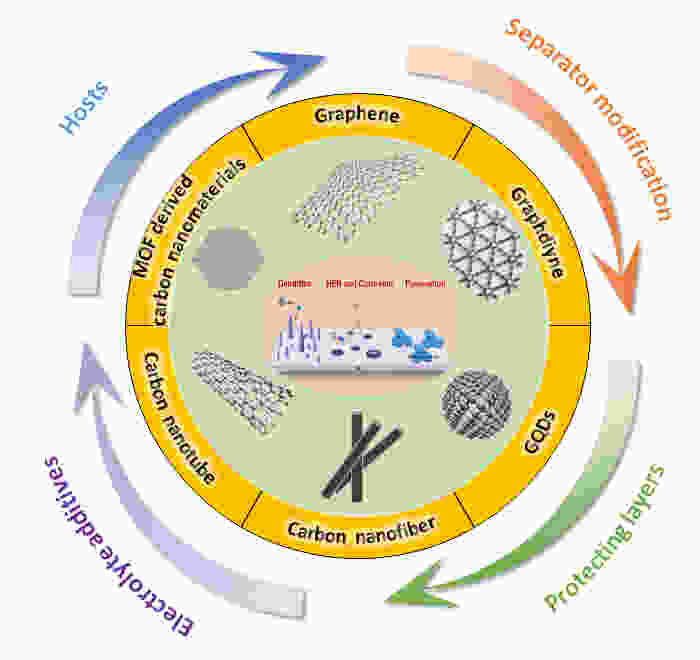
 下载:
下载:
